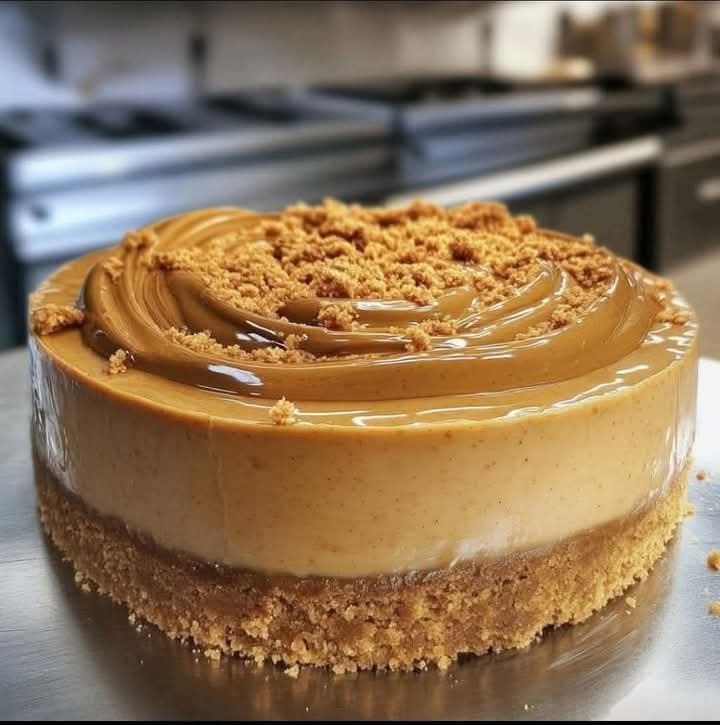 Pin it
Pin it
This indulgent Biscoff Cookie Butter Cheesecake transforms the beloved spiced cookies into a luxurious dessert that balances creamy cheesecake with the warm, caramelized flavor of Biscoff cookies. The combination creates a show-stopping treat perfect for special occasions or whenever you crave something truly spectacular.
I first made this cheesecake for my sister's birthday after she returned from Europe obsessed with Biscoff cookies. The moment she took her first bite, her eyes widened with delight, and now this has become our family's most requested celebration dessert.
Ingredients
- Biscoff cookies: For a distinctive spiced caramel flavor that forms the perfect foundation
- Cream cheese: Use full-fat blocks for the richest texture and avoid tub varieties
- Biscoff cookie butter: The star ingredient that infuses every bite with that iconic speculoos flavor
- Heavy cream: Adds silkiness to the filling and helps prevent cracks
- Vanilla extract: Enhances the overall flavor profile without competing with the Biscoff
- Eggs: Provide structure and that classic cheesecake richness
Step-by-Step Instructions
- Prepare the Crust:
- Combine Biscoff cookie crumbs with sugar and melted butter until the mixture resembles wet sand. Press firmly into the springform pan using the bottom of a measuring cup to create an even layer with a slight rim up the sides. Baking the crust briefly helps it set and prevents sogginess when the filling is added.
- Create the Filling:
- Beat the cream cheese until completely smooth before adding sugar. Any lumps now will remain in the final cheesecake. When incorporating the cookie butter, use a spatula to scrape down the sides frequently ensuring perfect integration. Add eggs one at a time, mixing just until each disappears to prevent incorporating too much air which can cause cracks.
- Bake with Care:
- The water bath is non-negotiable for this cheesecake. It regulates temperature and provides gentle, even heat that prevents the dreaded crack across the top. Wrap your springform pan in aluminum foil before placing it in the water bath to prevent water seepage. The cheesecake is done when the edges are set but the center still has a slight jiggle.
- Cooling Process:
- The gradual cooling in the oven prevents the dramatic temperature change that often causes cheesecakes to crack and sink. After the hour in the oven, continue cooling at room temperature before refrigerating. Patience during this step ensures the perfect texture.
- Final Touches:
- Wait until the cheesecake is completely chilled before adding the melted cookie butter topping. Heat the cookie butter just until pourable but not hot to prevent melting the cheesecake beneath. The cookie crumb garnish adds texture contrast and visual appeal.
The Biscoff cookie butter is truly the magical element in this recipe. I remember watching my nephew taste test the cookie butter straight from the jar while I was making this cheesecake. His face lit up with such joy that I ended up giving him a small bowl of it to enjoy while waiting for the cheesecake to chill.
Troubleshooting Your Cheesecake
The most common issue with cheesecakes is cracking. Beyond the water bath, avoid overmixing after adding the eggs and resist the urge to open the oven door during baking. If cracks do appear, the cookie butter topping will conveniently cover them! For clean slices, dip your knife in hot water and wipe clean between cuts.
Make It Your Own
While traditional Biscoff cookies create the authentic flavor, graham crackers or digestive biscuits can substitute for the crust in a pinch. For a deeper flavor profile, try browning the butter before mixing it into the crust. You can also add a thin layer of chocolate ganache between the cheesecake and cookie butter topping for chocolate lovers in your life.
Serving Suggestions
This cheesecake is rich enough to serve on its own, but a dollop of lightly sweetened whipped cream creates a beautiful contrast. For an elevated presentation, serve with a small scoop of vanilla ice cream and a drizzle of warm cookie butter sauce. Cut small slices as this dessert is decadently rich and satisfying even in modest portions.
Enjoy every rich bite of this indulgent cheesecake, and don't forget to share the magic with loved ones!
Frequently Asked Questions
- → How can I prevent my cheesecake from cracking?
To avoid cracks, use a water bath to provide even heat. Also, avoid overmixing the batter and let the cheesecake cool gradually in the oven with the door slightly open.
- → Can I use a different type of cookie for the crust?
Yes, while Biscoff cookies offer a unique caramel flavor, you can substitute graham crackers or digestive biscuits for the crust if preferred.
- → How long should I refrigerate the cheesecake?
Refrigerate the cheesecake for at least 4 hours, though overnight chilling is ideal for it to fully set and develop the best texture.
- → What is the best way to melt the Biscoff cookie butter for the topping?
To melt the cookie butter, place it in a microwave-safe bowl and heat at 15-second intervals, stirring in between, until smooth.
- → Can I make this cheesecake ahead of time?
Absolutely! This cheesecake can be made a day or two in advance and stored in the fridge. Add the topping just before serving for the freshest presentation.
